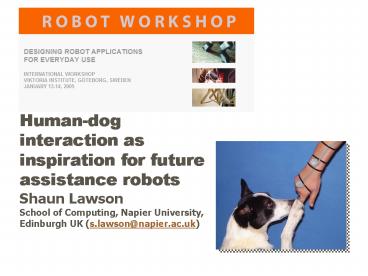Robot Workshop - PowerPoint PPT Presentation
1 / 8
Title:
Robot Workshop
Description:
A system that could detect the impending onset of a seizure has the ... the Canine Behaviour Centre, at the School. of Psychology, Queen's University Belfast, ... – PowerPoint PPT presentation
Number of Views:30
Avg rating:3.0/5.0
Title: Robot Workshop
1
Human-dog interaction as inspiration for future
assistance robots Shaun Lawson School of
Computing, Napier University, Edinburgh UK
(s.lawson_at_napier.ac.uk)
2
Seizures and their prediction ROBOT WORKSHOP,
VIKTORIA INSTITUTE, JAN 2005
- It is estimated that 1 in every 133, or 5.5
million, people in Europe, have epilepsy, of
which a quarter can have seizures which cannot be
controlled by any therapy. - A system that could detect the impending onset of
a seizure has the potential to create a
significant improvement to the quality of life of
many such people. - Almost all research in seizure prediction to-date
has concentrated on the off-line analysis of
recorded electroencephalographic (EEG) signals. - However, no definitive conclusions on the sensor
system required, the modelling and manual
classification of typical data, or the most
appropriate algorithms for the machine processing
of data have emerged.
3
Seizure Alert Dogs ROBOT WORKSHOP, VIKTORIA
INSTITUTE, JAN 2005
- There is mounting evidence to suggest that dogs
can, very reliably, predict the onset of a
seizure in their owners. - This ability can be exhibited by dogs with no
formal training, however most are trained by
organisations such as the Support Dogs charity in
Sheffield in the UK. - It is currently unclear as to exactly how dogs
recognise pre-seizure conditions, though work to
date indicates that they rely primarily on visual
cues such as facial expressions, postures and
general behaviour as opposed, for example, to
olfactory and auditory cues. - Other physiological cues such as muscle tension,
respiratory and perspiration might also be
monitored by dogs using visual, olfactory or
auditory senses.
4
Are they any good at it? ROBOT WORKSHOP,
VIKTORIA INSTITUTE, JAN 2005
- Other researchers, both clinicians and computer
scientists, are usually very sniffy about
Seizure Alert Dogs. - Support Dogs have reported that, once trained,
every dog in a study group of six animals was
able to predict every subsequent seizure in their
owner. - The advance warning period between dogs did vary
from 45 to 10 minutes but, once training for an
individual dog was complete, this warning time
did not vary. - Interestingly dogs have also been shown to reduce
the frequency of seizures over time.
Support Dog - Harvey
5
Our project ROBOT WORKSHOP, VIKTORIA INSTITUTE,
JAN 2005
- A small inter-disciplinary research consortium
has been formed the HCI Group at Napier, the
Canine Behaviour Centre, at the School of
Psychology, Queen's University Belfast, and the
Support Dogs charity. - We also have a clinical partner to advise on
ethics etc. - We are attempting to exploit the ability of
trained Seizure Alert Dogs to inform the
development of software and systems that can
detect seizures well in advance of any previously
proposed artificial methods. - A proposal for a 3 year study is ready for
submission to the UK EPSRC AIBACS (Adaptive and
Interactive Behaviour of Animal Computational
Systems) programme.
6
Objectives of the project ROBOT WORKSHOP,
VIKTORIA INSTITUTE, JAN 2005
- To determine the stimuli used by trained Seizure
Alert Dogs when seizure alerting. - To develop visual and physiological sensor
systems to monitor, as closely as is possible,
the same behavioural and physiological signs as
the dogs and to use dogs to label or classify the
output of the sensor systems. - To apply and develop soft computing systems for
autonomously classifying sensor data, acquired
under realistic conditions, as pre-seizure or
normal, and to use dogs to evaluate the
effectiveness of such systems. - To improve Seizure Alert Dog selection and
training and to assess the potential of creating
assistive technology for deployment in homes, or
worn by a user, in the future.
7
Dog-human interaction ROBOT WORKSHOP, VIKTORIA
INSTITUTE, JAN 2005
- As is evident in the lack of current knowledge
about how dogs perform seizure alerting, the
complexities of dog-human social cognition are
not yet fully understood. - Pioneering work is ongoing in this area by the
likes of Wells, Mills et al in the UK and
elsewhere by Miklósi and Pongrácz et al. - Some observations of dog-human inter-action have
been used by computer scientists to inform the
construction of a number of, mostly
entertainment-based, systems. - The Synthetic Characters group at MIT have
reported a number of simulations that exhibit
both dog-dog and dog-human interactions whilst
dog-like robotic toys, most famously the Sony
AIBO, can now be easily purchased.
8
Embodiment of systems? ROBOT WORKSHOP, VIKTORIA
INSTITUTE, JAN 2005
- If successful, our project will make a
contribution towards future Electronic Assistive
Technology (EAT) systems which aim to determine
the state of health of an individual. - It is inevitable that future EAT systems will
also exploit advances in technologies such as
ubiquitous, ambient and wearable computing and we
have proposed passive sensor based solutions as a
first generation system. - However the social acceptance of invisible
pervasive monitoring systems is predicted to be
patchy at best. - Perhaps more significant for our work is that
dogs probably use interaction with our humans to
predict seizures and also that interaction with
dogs reduces seizures. - So in future, will we see Aibo wearing the
Support Dog vest?































